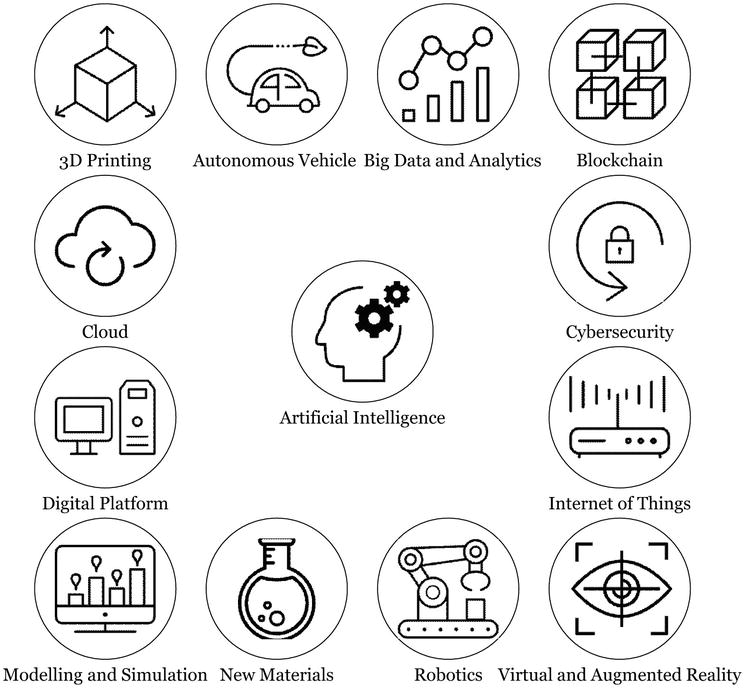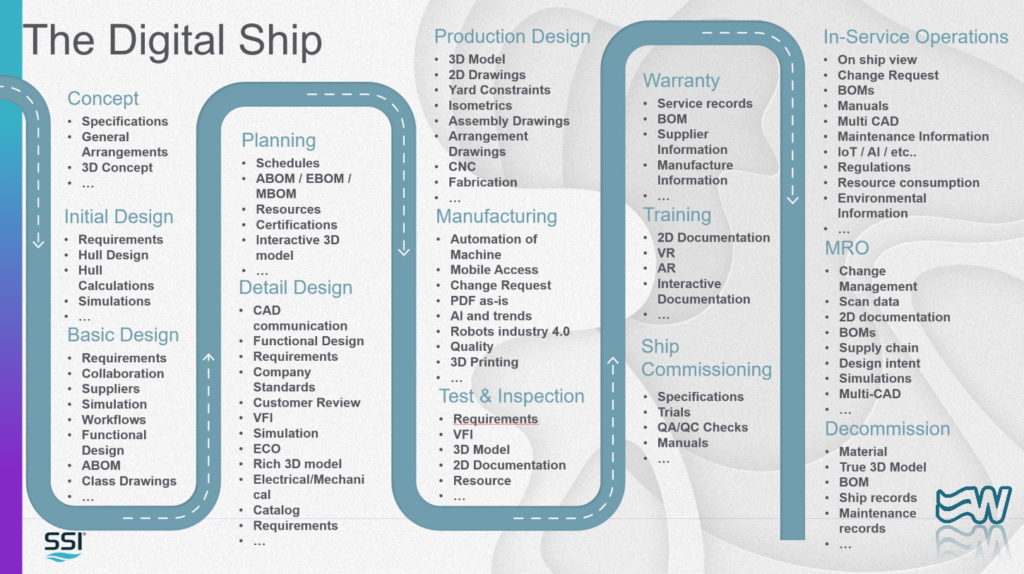Innovation is one of the hottest buzzwords in shipbuilding. Everyone is looking to find or implement it somewhere. We ourselves are guilty of using it frequently as a stand-in for the individual technologies that are augmenting the way shipbuilders approach their projects. However, innovation truly consists of three key pillars: the trends, the architecture, and the mindset. This post will hopefully help make clear those distinctions and how they influence true innovation.

Digital Shipbuilding
Get a first-hand experience of what the design, build, and maintenance phases are like in an increasingly digital shipyard.
Experience nowThe Trends
Innovation is the shorthand we’ve frequently used to refer to these tech trends. To name a few: IoT, AR, VR, 3D printing, AI, etc. (see graphic below). These are the technologies that spring to mind when we refer to a ‘digital shipyard,’ Shipbuilding 4.0, or, more broadly, Industry 4.0. However, at the end of the day, these are just trends. The specific mix of new technologies will always be changing.

In the past, we’ve seen how organizations can fall into the trap of these trends, implementing technology for the sake of ‘being able to use it’ rather than to solve a real problem. For a closer look at the potential impacts of all of these individual trends on the future of shipbuilding, make sure to check out Denis’ blog series: Future of Shipbuilding (15+ years)
The Architecture
While useful on their own, individually, these tech trends can only solve specific challenges. What allows them to truly impact the organization as a whole is when the data from every piece can be accessed through a single source of truth. When every department accesses the information housed in that source of truth, the effects of these individual innovations are multiplied.
The connected information of all the technologies within our shipyard is what forms the digital twin. The disparate and opaque systems of the past have put blinders on the insights these technologies can provide beyond just engineering. In the past, the missing piece has been the integration that makes that connection possible.

Now, the strategy that shipyards are getting results with is known as platform of platforms. For those new to the idea, Denis Morais has a succinct description of this concept on his Waveform blog:
“The general idea is that you will have several “larger” platforms which will contain information that is of high cohesion (related to each other) and some specific “apps” that will be tightly connected to that platform. These platforms would be designed specifically for this platform of platform ecosystem and therefore as a first-class citizen would be able to connect, link, synchronize, federate, transfer, etc. information and processes to other platforms. This is a fundamental difference compared to most (so called) platforms available today. However, more and more platforms are starting/attempting to become more “open” and participate in this environment.”
With this strategy in place, the remaining missing piece is establishing a single source of truth. However, with all the information linked in a useable manner, a shipbuilding specific PLM system is one potential information management solution that shipyards are turning to.
Fundamentally, the goals of any solution will be to:
- Maintain a history of all your data over time.
- Control how and when documentation is passed on.
- Ensure that every team is working with up-to-date information from every source.
- Push information to whoever or wherever it is needed in the appropriate format.
With all these elements in place, implementing the latest technologies is easier than before and provides more true value to the organization.
The Organizational Mindset
What may be more important to achieving true innovation within the shipyard than the trends and architecture in place is the mindset of leadership. Creating a culture of innovation will drive change more than any individual technology.
As an example, the Royal Canadian Navy (RCN) has committed to creating that culture. One of the most innovative changes they’ve made has not involved any new technology trend at all. By better tracking a sailor’s activities at sea, they can ensure that the individual has the skills and knowledge they need, without them setting foot in a classroom. Ultimately minimizing the number of ‘off-duty’ hours spent training.
But even in terms of implementing new technologies, leadership that embraces innovation will be more likely to work on improving and changing the way we approach processes. Rather than augmenting the ‘old way’ of doing things with new technology, a new digital-first way can emerge. We are certainly seeing the impact of this shift take hold across the industry. One example comes from class societies, and the move towards accepting 3D class approvals. On the surface, the change can be considered to result in a time-savings from not having to create otherwise redundant 2D drawings; however, the move to 3D also makes it easier for the shipbuilder to identify problems over time, deliver more accurate assets to the owner, etc.
The Result
Overall, innovation is not a one-size-fits-all concept. The mix of underlying technological trends, information architecture, and cultural mindset will differ for every shipbuilder. However, understanding how each of these pieces fits together can clear up the misconceptions about what is actually needed.
To keep up with the latest developments in our industry, make sure to sign up for our innovation newsletter. Each month, we round-up articles and explore strategies to manage the evolving trends, architecture, and culture within shipbuilding,
